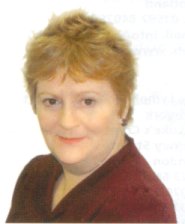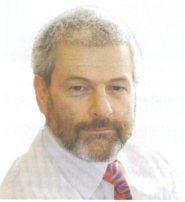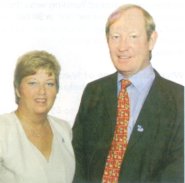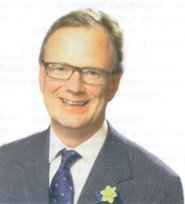Originally published in September-October 2004 icon
Melanie Hart Interviews Major Charity Supremos
3:
Angela Dickson [SDRT4:
Tom Hughes-Hallett [Marie Curie Cancer Care Running a cancer charity is hard work, but not a thankless task. Helping support, advise and improve the care of those living with cancer, and being at the cutting edge of researching ways to prevent and cure the disease are just some of the rewards these chief executive officers enjoy and are striving towards.

1: Joanne Rule
With a background as a communicator and lobbyist, Joanne Rule was always going to hit the ground running when she joined Cancer BACUP as CEO in February 2001, and she intends to keep focusing on the decision makers to improve the UK’s cancer services.
She was previously CEO at the British Dyslexia Association and, before that, Director of Corporate Affairs at the Royal College of Nursing.
Q:
Were there any personal reasons why you decided to head Cancer BACUP?A:
The experience I had, my interest in health and the fact that my mother had been diagnosed with breast cancer, two or three years earlier, all made me think, "Oh, this really is the job I would like!" My mother is now doing really well, but I can remember her saying after her mastectomy "I don’t mind dying, but you will make sure I’m not in any pain..." Not knowing what I know now, we thought the end was a lot sooner.
Q:
What do you see as the most important aspects of your role? A:
Making sure that the organisation continues, not just on a good financial footing, but that we’re able to grow. I am a lay person, and that’s how I approach my role. It’s terribly important that we employ people with cancer expertise, to answer the phones and write the copy for the website etc. but I don’t have to be a cancer expert. I also have to make sure that we’re out there lobbying and banging the drum, saying "It’s outrageous that people don’t have access to high quality patent information!"
Q:
How would you like the public to perceive Cancer BACUP? A:
I’d like them to know about us, and realise that they can, literally, ask us any question about any cancer. We’re told over and over again by people who phone up or drop into a local centre, "I wish I’d known about you sooner".
Q:
What does your charity do best? A:
We give people affected by cancer up-to-date information, practical advice and support to reduce the fear and uncertainty. Our website is a phenomenal shop window and we have nearly a quarter of a million unique visitors every month.
Q:
How much money did you raise in the last financial year, and how much did you receive from the Government or other bodies?A:
We raised more than 4 million (47 per cent from individual donations, 22 per cent from companies and charitable trusts, and nine per cent from special events and treks). The Government gives us very little, an occasional grant for an occasional project.
Q:
What percentage of Cancer BACUP’s income is spent on helping those living with cancer?A:
early 50 per cent is spent on our cancer support service, nearly 20 per cent on patient information and publications, six per cent on advocacy, being the voice of patient information issues.
Q:
Do you have annual figures on how many people you help?A:
We talk to 60,000 people a year on the phone, or face-to-face at our six local centres. We also distribute more than a quarter of a million booklets.
Q:
What is your stand on complementary therapies?A:
We believe that complementary therapies really help people feel that they have some sense of control and that they are really important (particularly massage and visualisation) in supporting people through treatment and nausea. We do distinguish between complementary and alternative therapies. It is not our role to be judgmental. We give people all the facts research bases and information we can.
Q:
What have been the high points so far, of your time as CEO?A:
The main achievement is that people can now get through to Cancer BACUP without having to ring two or three times, and we’ve employed more nurses to respond to calls. In 2002 we won the Telephone Helpline Association’s award for "helpline service of the year’.
Q:
What are you still aiming to do?A:
This year we want to open until 8pm so that more commuters, and people travelling from outpatient clinics, can call. We’re also going to do more for young people with cancer, building a teenage cancer website as part of our own. Cancer BACUP is going be much more focused on the policy makers and politicians to speed up the time people spend waiting for treatment. We’re also planning to raise awareness on cancer and fertility towards because there’s a real lack of information on the differential effects on fertility of particular drugs. We need to make sure that cancer services remain a national priority with the public and politicians in the run-up to the next Election.
Freephone UK helpline 080 8800 1234, Website: http://www.cancerbacup.org.uk.

2: Peter Cardy
A prolific writer and speaker, Peter Cardy spent his early career in adult education, and at the National Centre for Volunteering, before heading the Motor Neurone Disease Association.
From 1994 Peter was Chief Executive at the UK Multiple Sclerosis Society. He joined Macmillan Cancer Relief at the end of 2001.
Q:
Why did you decide to head Macmillan?A:
Because they asked me. I knew a bit about Macmillan from my time at the MS Society and MND Association, as we’d tried to model some of our work on theirs, but, like most people I thought that Macmillan just provided nurses. Working here has been one revelation after another
Q:
What do you see as the most important aspects of your role?A:
To have vision on behalf of the charity, to peer as far into the future as possible and convert that vision into leadership. The inexorable growth of cancer is a problem that will not be solved in the next generation. There are lots of good news stories - about cancer being cured, people in remission and living longer - but the number of people diagnosed is going up, driven by ageing and unhealthy living.
Q:
How would you like the public to perceive Macmillan?A:
As the organisation that makes a difference to people affected by cancer now and in the future. We are working towards creating better services for people who’ve not yet been diagnosed.
Q:
What does your charity do best?A:
We’re like Oxfam, a development organisation. We make things happen. Most of what we do is to put in the initial funding for nurses, doctors, radiographers, dieticians, information officers. There are now more than 3,200 of these posts, predominantly in the NHS as well as in our hospices, and all these people are trying to improve the practice of their colleagues. On the building side, our biggest effort is in building cancer treatment centres, mostly within NHS hospitals. Princess Alexandra opened one at King George’s Hospital in Ilford, Essex, for us earlier this year. I think of these centres as creating a beautiful environment for an ugly disease.
Q:
How much money did Macmillan raise in the last financial year, and how much did you receive from the Government or other bodies?A:
Our financial year ended in December 2003, and our provisional figures are total fundraised income 85million and total income 89 million. We do a certain amount of co-funding with the Government, where we put in 50 per cent and so do they. Because we raise so much we can be completely independent.
Q:
What percentage of Macmillan’s Income is spent on helping those living with cancer?A:
Its increased since 2002 to 65 per cent of our Income (52.5 million) in 2003. Our fundraising costs for 2003 were 20 per cent - a reduction on the previous year.
Q:
Do you have annual figures on how many people you help?A:
Not exactly, but if you take the average caseload of a Macmillan nurse, as 150 a year, and multiply by 2600 nurses, that’s 390,000. But the effect of what they do is much wider because they work with professionals, so in a sense everyone with cancer benefits from Macmillan.
Q:
What is Macmillan’s stand on complementary therapies?A:
Some caution. There is this nave assumption that if it’s natural it’s OK, but tobacco is natural! We’ve learnt about things like St John’s Wort, and some of the traditional herbal remedies which have plant hormones which interact with hormone treatments for breast and genital cancers. But with that note of caution, we are enthusiastic about complementary therapies and produce a directory of them. The amazing thing is how extensive NHS provision of these therapies is.
Q:
What have been the high points so far, of your time as CEO?A:
Just every day. It is such an extraordinary organisation and the staff, volunteers and trustees are great. They’re the best and most highly motivated team I’ve ever worked with. I’m very pleased with the mobile information centre we started a couple of years ago. It does an annual tour, in shopping centres and public places for nine months, and a lot more men come to that than to any other information Source. I’m also pleased that we have brought a lot of people into a common research framework so that the quality of our research will be more consistent. There is a famine of research into cancer care. We will start to produce papers in 2005 from our National Listening Exercise, where we’re talking to hundreds of people affected by cancer about what they think the priorities should be, finding a cure, trying to improve and control distressing symptoms or organising the services better.
Freephone 0808 808 2020; email: cancerline@macmillan.org.uk web: http://www.macmillan.org.uk.

3: Angela Dickson
Angela Dickson set up the Samantha Dickson Research Trust (SDRT) with her husband Neil in 1996 following their daughter’s battle with brain cancer.
Angela previously worked as a PA for a director of a large London company, before having her three children.
Q:
Why did you decide to set up and head SDRT? A:
Our lives were shattered when Samantha was diagnosed with a brain tumour at the age of 14. She had never been ill and fought hard for two and a half years before losing the battle on 31st October 1996. During Samantha’s illness, Neil tried to find out what research was being done for brain tumours and was appalled at the lack of funding, especially as this is the second most common childhood cancer and also kills 3000 adults a year.
So, rather than put our money in the general cancer pot, we wanted it to go specifically to brain tumour research. Our first 20,000 was given to two brain tumour research hospitals. However, we decided to do something more positive and set up the charity. Within the first two years we were funding six full research projects, which were being monitored by our trustees. Since then we have funded 16 research projects one of which has now progressed to clinical trials. In spring 2004 we started sponsoring eight projects, and have encouraged five other charities to share a further four with us.
Q:
What do you see as the most important aspects of your role?A:
Having experienced the effect that a brain tumour can have on, not only my daughter, but all the family; and all the problems associated with dealing with radiotherapy, chemotherapy, loss of schooling, disability problems, and later having to nurse Samantba at home, I feel I can relate to others who seek advice and moral support, or have lost a loved one. I am one of only two members who represent patients and their carers on the NICE Group Guidance Committee for Brain and Spinal Tumours. (NICE = National Institute for Clinical Excellence.) This is a major initiative by the Government and an Independent body to establish national guidelines for patient care under the NHS.
Q:
How would you like the public to perceive the SDRT?A:
As the number one charity for anyone with a brain tumour. We are there if people seek advice, require support, or want to make a donation for research. We have become the largest funder of laboratory-based brain tumour research in the UK, and are keen to make sure we are funding the best research available. It is hard to raise funds and, if given in memory of a loved one, important to see that they are used wisely to help find a cure or increased survivability for others in the future.
Q:
How much money did SDRT raise in the last financial year. and how much did you receive from the Government or other bodies?A:
We raised just over 6000,000 and have received no help from the Government. We have received a Community Fund grant of 147,624 (1999 - 2002) for a research project. A new grant of 105,204 has just been awarded for 2004 - 2005) for a project to ’tackle the delays in diagnosis for brain and spinal tumours’ - a major concern for both specialists and patients.
Q:
What percentage of SDRT’s income spent on helping those living with cancer?A:
All our income raised and donated to the charity over the last seven years has gone into funding medical research. We have not kept a record of telephone, postage, printing, costs, or anything else involved with patients up until 1 April 2004 as this has not come out of charity funds but has been paid for personally and with the help of volunteers. I also have the help of Karen Harris-St John who works three days a week on a voluntary basis like myself. It has personally cost my husband and his company approx. 60,000 to run the charity per year on admin costs, the majority of which is for our continued patient support and trying to raise awareness and funding.
Q:
Do you have annual figures on how many people you help?A:
No, but it would be about 500. As our research develops, producing a better understanding of the disease and improved survivability, this will increase to about 5,000 in the UK alone. Calls often come from other charities, as they know we specialise in information for brain tumour patients. The SDRT office is at home, so I often receive calls in the evening, when a parent or carer has more freedom to call. At least a quarter of my time is spent supporting people.
Q:
What is SDRTs stand on complementary therapies?A:
We have a very open mind. We have funded a project on Citrus Flavonoids, and receive applications from various groups with alternative therapies. All are passed through our Scientific and Medical Advisory Board. I am also a strong believer in a good, balanced diet, and often quote iCON magazine to patients and believe many of them now have a standing order for the magazine to be sent direct.
Q:
What have been the high points, so far, of your time at SDRT?A:
Definitely when we hit the tabloids with the headline "largest single funder of laboratory-based brain tumour research in the UK". We intended to double the UK’s performance in research in this field in the first five years, and actually achieved this after only three! Other high points inchde raising 135,000 at a charity ball at The Dorchester last October. The biggest accolade was receiving an invitation to attend a reception at Buckingbam Palace for "Pioneers who have made a Contribution to the Life of the Nation". There were so many important people present, including Nelson Mandela, Margaret Thatcher, Sir Richard Attenborough. Just walking up the huge red velvet carpeted staircase was something I shall always treasure.
Q:
And the greatest challenge?A:
To find a cure for this devastating disease in my lifetime. It is the only way I can cope with having lost our beautiful daughter. It has been recently announced in the USA that more children die from brain cancer than leukaemia. This is due to the tremendous success of leukaemia research over the last 20 years. A child diagnosed with an inoperable brain tumour has only a 20 per cent chance of surviving for five years. A child with leukaemia has more than an 85 per cent chance of survival for life.
We need to do something now!Tel: 08401 309 733; email: SDRT1996@aol.com; web: http://www.sdrt.co.uk.

4: Tom Hughes-Hallet
After qualifying as a barrister, Tom Hughes-Hallett spent more than 20 years working in the City before giving up his job, as director of Fleming Asset Management to join Marie Curie in December 2000.
Q:
Why did you decide to head Marie Curie?A:
I worked for a decade across the desk from my business partner who died from bowel cancer when he was 40. At the end he was nursed by Marie Curie nurses, so when I saw the job advertised I called his widow and she said I had to do it because "it is the most fantastic organisation".
Q:
What do you see as the most important aspects of your role?A:
First and foremost to ensure that clinical excellence is demonstrated at every level. It is equally the job of the CEO to ensure that there is a stable financial base to operate and grow against. Perhaps slightly unusually, when I joined also took on the role of fundraising director for my first two years here. It nearly finished me off, but I’m glad I did it to understand how everything worked. Marie Curie is a substantial employer, so the third thing is to make sure we value our work-force - the majority of whom are lone workers.
Q:
How would you like the public to perceive Marie Curie?A:
As an organisation that at the end of their lives gives people the choice to die at home and have the most dignified death they possibly can. We’re known for our clinical excellence, but it’s much more than that. Its about the human side of meeting people’s wishes. I met a wonderful woman in a hospice last year who had come back from America to die in Bradford. I asked her what had made a difference to her. "I’m a Yorkshire woman through and through," she said, "and I haven’t been able to eat wheat because of my cancer, but your chef made me a Yorkshire puddingl" He’d found a special flour she wasn’t allergic to. That was far more important to her than any pain relief. Our charity makes a difference.
Q:
How much money did you raise in the last financial year and how much did you receive from the Government or other bodies?A:
83million, of which the NHS contributed 15 million.
Q:
What percentage is spent on helping those living with cancer?A:
We spent more than 42 million last year directly on the care of people with cancer and a further 3.5 million on research.
Q:
Do you have annual figures on how many people you help?A:
We look after half the people who die at home of cancer. We care for 25,000 patients a year in hospices, and their own homes, plus giving advice on the phone to their families, which can be up to five people per patient. And we go onlooking after relatives after the patient has died, through our bereavement services.
Q:
What is Marie Curie’s stand on complementary therapies?A:
Very supportive, and not just for the patient. If you bring your loved one into our hospice in Caterbam, while he or she is being seen by our doctor you’re likely to have a nice shoulder massage yourself. If there’s a local volunteer offering reiki, shiatsu, yoga, aromatherapy, reflexology, hynotherapy or relaxation sessions we will have them in our hospices. We believe in giving people anything that will help them, so long as it doesn’t harm them, and are putting complementary therapy advisory leaflets in our 10 hospices. One of our doctors has led a big research project, studying 300 patients at Hampstead Royal Free Hospital, to demonstrate the effectiveness of aromatherapy massage. Dr Susie Wilkinson’s project has just finished after five years and the results indicate that aromatherapy massage helps with anxiety, fatigue and in improving the quality of life.
Q:
What have been the high points so far, of your time as CEO?A:
There are wonderful corporate things, like our new hospice in Bradford, but I have to say my personal triumphs would all be about individuals. We’ve just had the first wedding at one of our hospices, arranged at very short notice. One of my favourites though is the little boy who desperately wanted to go to the Natural History Museum. We’d arranged it, but he was too ill. He was sitting at home one day when he saw a removal van pull up outside. We’d managed to persuade the museum’s staff to bring some of the exhibits to him. Giving that sort of quality to peoples lives is more important to me than anything else.
Q:
And the greatest challenges?A:
I would say it’s providing a reliable service. Ensuring that every time someone is referred to us that we can guarantee to provide a nurse. If there’s great demand on our service, where there’s a shortage of nursing staff, then it can’t always be so and we regard that as a failure. We will not rest until we know that we’re always there when were needed. I want to double the number of people who have the choice to die at home in the next 10 years, and this year Marie Curie will be devoting more resources to develop more research into better care for people who are very ill with cancer. There’s far too little research being done into the provision of better palliative care in this country.
Freephone helpline: 0800 716 146; email: info@mariecurie.org.uk; web: http://www.mariecurie.org.uk.